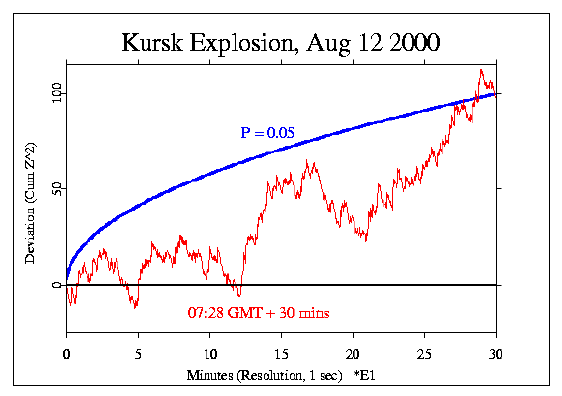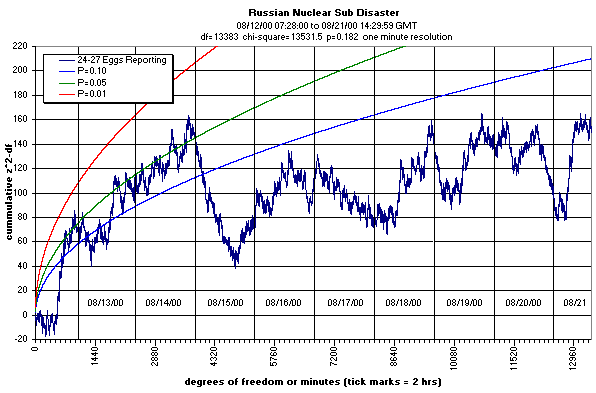|
On 12 August, an explosion wrecked the Russian submarien Kursk, and it
sank in the Barents sea with 118 crew aboard. The public was not aware
of the tragedy for two days, but the Russian navy located the submarine
early on the 13th and began rescue efforts. For the first two days
there was, according to reports, detectable knocking on the hull
indicating some survivors. The event understandably engaged
widespread attention, both because of the tragedy for the crew and their
families, and because it represented political and societal issues on a
world-relevant scale.
A detailed timeline of the 10-day episode is given below.
A formal GCP prediction was made for the event, specifying a half hour beginning
with the first explosion, at 07:28 GMT, at one-second resolution, and a
long-term look at the whole period
until resolution (access and confirmation that all are indeed dead)
using one-minute blocks.
These analyses are shown in the following graphs
of the cumulative deviation of Chisquare. The final value of Chisquare
for the half-hour period
is 1898.4 on 1800 degrees of freedom, which has an associated
probability of 0.052.

Ten Days of Waiting
The period from the 12th to the 21st of August, beginning with the
accident and ending with the official announcement
that all of the Kursk crew were dead, is shown in
George deBeaumont's graphic presentation of the one-minute
long term look at the data. The analysis timing is based upon:
1) First explosion at 08/12/00 07:28:27 GMT and 2) BBC
website reports all crew dead at 08/21/00 14:29 GMT
Chisquare is 13531.5 on 13383 degrees of freedom, with p = 0.182.
The first two days, during which knocking on the hull was detected, show
a highly significant rise. After that, the data fluctuate with no
long-term trend. As a picture rather than a scientific measure, the
graph looks like an unfolding story, with intense engagement for the
first two days, then confusion over the next week.
See the timeline below for a more detailed description of the events
over the whole period.

The following timeline is from the BBC website. Notes in [brackets]
are from the chronology published in the Trierischer Volksfreund
on 21 August 2000.
Day one: Saturday 12 August
Russia's Northern Fleet Command loses
contact with the Kursk nuclear
submarine taking part in exercises in the
Barents Sea. [Norwegian seismologists register two underwater explosions
at about 09:30 MESZ (07:30 GMT). It is probably the accident of the Kursk.]
Day two: Sunday 13
A Russian sonic depth finder from the
Pyotr Veliky cruiser finds the submarine,
which has sunk to the sea bed at a
depth of 108 metres, approximately
135km (85 miles) off Severomorsk. [The sub is located at 01:21 MESZ.
Russian ships arrive seven hours later. Knocking signals are heard from
the sub asking for help.]
Day three: Monday 14
A Russian navy official admits that the
Kursk is on the seabed. It is claimed
radio contact was made with submarine.
This is later denied - the only way that
survivors can communicate with their
rescuers is by knocking on the hull. [The announcement is made shortly
before 09:00 MESZ, 48 hours after the accident.]
Officials say there are no nuclear
weapons on the Kursk and say that the
submarine's nuclear reactor has shut
down. The Russian navy says the
accident happened on Sunday.
Russian officials play down reports that
the Kursk collided with a foreign vessel,
and suggest that an explosion took place
on board.
The UK and the US are among nations
that offer to help Russian rescue efforts.
There are unofficial reports that the
knocking on the Kursk has stopped.
Day four: Tuesday 15
First unofficial reports emerge from
Washington that US submarines
monitored two explosions in the area
where the Kursk sank.
Raging storm hampers rescue efforts.
The Russian navy attempts to lower a
submersible vessel to the Kursk. Strong
currents and the angle at which the sub
is lying on the seabed mean that the
submersible fails to latch onto the Kursk.
Day five: Wednesday 16
Poor underwater visibility hampers rescue
efforts. New attempts to dock with the
Kursk fail.
President Vladimir Putin, who is on
holiday in southern Russia, makes his
first public comment on the crisis. He
describes the situation as critical and
says Russia has everything it needs to
conduct the rescue mission.
Shortly afterwards, Deputy Prime
Minister Ilya Klebanov says that there
are no signs of life on the submarine.
Late on Wednesday, Russia formally asks
the UK and Norway for help.
A plane carrying British navy LR5
mini-submarine leaves Scotland for
Trondheim, Norway.
Day six: Thursday 17
Further Russian attempts to dock with
the Kursk fail.
The supply ship carrying the British LR5
and crew sails from Trondheim. The
Seaway Eagle, carrying Norwegian
divers, heads for the scene of the
accident.
Russian officials report extensive damage
to the Kursk, saying the entire bow has
been ripped open. It is reported that
many of the crew were likely to have
been in the sections of the submarine
destroyed by the impact and are
believed to have died instantly.
Day seven: Friday 18
A Norwegian seismological institute says
it registered two powerful explosions on
Saturday in the area of the accident at
approximately 0730 GMT.
A Russian rescue capsule briefly latches
on to the submarine. Damage to the
hatch prevents a secure docking,
Russian officials say.
President Putin returns to Moscow to
monitor the crisis.
Day eight: Saturday 19
The British rescue team and the LR5,
arrives at the scene of the disaster but
is not deployed.
The Norwegian ship, the Seaway Eagle,
carrying Norwegian divers arrives at
scene.
Day nine: Sunday 20
A remote-controlled camera goes down
to Kursk from Seaway Eagle to inspect
the body of the submarine.
The first Norwegian diver reaches the
sub.
Norwegian divers say the rear submarine
hatch is not too damaged to attempt
opening it.
Day ten: Monday 21 August
Norwegian divers open outer hatch. The
airlock below is found to be flooded with
water, but no bodies are discovered.
A few hours later, they open the airlock's
inner hatch. The cabin inside is flooded
and rescuers conclude the crew is dead.
The Russian navy officially announces
that all 118 crew are dead.
|